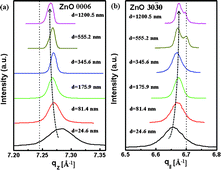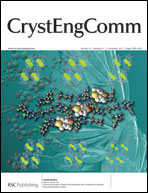Thickness-dependent lattice relaxation and the associated optical properties of ZnO epitaxial films grown on Si (111)
Abstract
The evolution of the strain state as a function of layer thickness of (0001) oriented ZnO epitaxial films grown by ![[2 with combining macron]](https://www.rsc.org/images/entities/char_0032_0304.gif) 0> oriented crack channels. The influence of the biaxial strain to the vibrational and optical properties of the ZnO layers were also studied by micro-Raman, optical reflectance, and photoluminescence. The deformation-potential parameters, aλ and bλ, of the E2(high) phonon mode are determined to be −740.8 ± 8.4 and −818.5 ± 14.8 cm−1, respectively. The excitonic transitions associated with the FXA, FXB, and D°XA emissions and the A-exciton binding energy all show linear dependence on the in-plane strain with a negative slope.
0> oriented crack channels. The influence of the biaxial strain to the vibrational and optical properties of the ZnO layers were also studied by micro-Raman, optical reflectance, and photoluminescence. The deformation-potential parameters, aλ and bλ, of the E2(high) phonon mode are determined to be −740.8 ± 8.4 and −818.5 ± 14.8 cm−1, respectively. The excitonic transitions associated with the FXA, FXB, and D°XA emissions and the A-exciton binding energy all show linear dependence on the in-plane strain with a negative slope.


 Please wait while we load your content...
Please wait while we load your content...